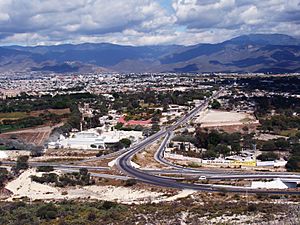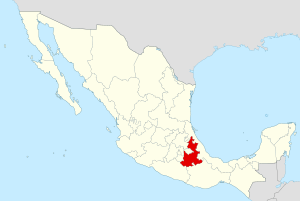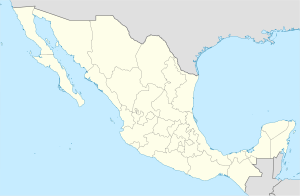Tehuacán facts for kids
Quick facts for kids
Tehuacan, Puebla
|
|
|---|---|
| Tehuacán | |
 |
|
| Nickname(s):
The Place of Gods
|
|
| Motto(s): | |

State of Puebla within Mexico
|
|
| Country | |
| State | Puebla |
| Founded | 15th century |
| Erected | March 16, 1660 |
| Area | |
| • Municipality | 553.57 km2 (213.73 sq mi) |
| • Urban | 27.83 km2 (10.75 sq mi) |
| Elevation | 1,600 m (5,200 ft) |
| Population
(2022)
|
|
| • Municipality | 357,621 |
| Time zone | UTC-6 (Central (US Central)) |
| Postal code (of seat) |
75710
|
| Area code(s) | 238 |
| Demonym | Tehuacanero |
Tehuacán (pronounced tewa-KAN) is the second largest city in the Mexican state of Puebla. It is located in the southeast part of the Tehuacán Valley. The city is close to the states of Oaxaca and Veracruz.
In 2010, the city had about 248,716 people living there. The whole area around the city, called the Tehuacán municipality, had about 274,906 people. Tehuacán is the main city for this municipality.
Contents
Culture and Traditions
Tehuacán started as a settlement for Native American people. It officially became a city in 1660, during the time of New Spain.
The city is famous for its many festivals. These events celebrate the old traditions and customs from the native people. One popular event is the Festival Internacional de Tehuacán 1660. This festival has been held for over 15 years. It showcases the city's art and culture.
In the late 1800s, Tehuacán became known for its mineral springs. A well-known soft drink company, Peñafiel, uses water from these springs. Tehuacán is also a major center for making eggs and chicken meat in Mexico.
Economy and Industry
The main way people make a living in the Tehuacán Valley is by raising chickens. The area is the second biggest producer of eggs in Mexico. Over 25 million hens live here. They also produce a lot of chickens for meat. Big companies like El Calvario and Mr. Egg are part of this industry.
After the NAFTA agreement was signed, many textile factories came to Tehuacán. These factories, called maquiladoras, mostly made blue jeans. They exported these jeans to big clothing companies like The Gap and Old Navy.
At one point, there were more than 700 maquiladoras in Tehuacán. Some even operated secretly from homes. This created many jobs, but it also caused the city to grow very quickly. In just ten years, Tehuacán's population jumped from 150,000 to 360,000 people. Many factories have closed since then, but over 700 were still operating in 2007.
Geography and Nature
Tehuacán is located in the southeastern part of Mexico. It shares borders with several other cities. To the north are Tepanco de López and Santiago Miahuatlán. To the east are Vicente Guerrero and Ajalpan. San Gabriel Chilac and Altepexi are to the south. To the west are Zapotitlán and San Martín Atexcal.
The city of Tehuacán has a mild climate. The temperature is usually around 19 degrees Celsius (66 degrees Fahrenheit) for most of the year. The Tehuacán Valley is a special place with many different plants and animals.
The area around Tehuacán is also known for earthquakes. This is because it is near the Neovolcanic Axis. This is a chain of volcanoes that runs through many Mexican states. Because of this volcanic activity, the ground in Tehuacán often moves. This happens especially during the summer and spring.
The Tehuacán Valley has a huge variety of plant and animal species. The Tehuacán-Cuicatlán Biosphere Reserve is a protected area nearby. It is home to over 200 types of cactus, and many of them are endangered. This makes it a very important place for nature.
Places to Visit
Tehuacán offers many fun things to do. You can explore outdoor areas or visit historical museums. These places share the long history of the region and Mexico.
Here are some popular places to visit:
- Peñafiel and Garci Crespo Natural Springs: These are underground tunnels where the famous "Agua Tehuacan" mineral water is produced. The water gets its bubbles and minerals from snow melting off volcanoes.
- The Ex-Convent of San Francisco: This old building was a monastery built in the 1500s. It was once a famous school for Latin. Its walls show the history of different time periods through their architecture and paintings.
- The Museum of Mineralogy: This museum has a special collection from Don Miguel Romero. He was an important person from Tehuacán. He gave the museum many valuable items. These include moonstones, fossil minerals, and meteorites found in the Tehuacán Valley.
- The Cactus Botanical Garden: This garden is about 30 minutes south of the city. It protects over 200 types of cactus. This makes it the place with the most diverse cactus ecosystem in the world.
Religion in Tehuacán
Catholicism is the main religion in Tehuacán. The Diocese of Tehuacán was created in 1962. Its main church is the Cathedral of Tehuacán. This cathedral is dedicated to "The Lady of the Immaculate Conception and Cave." The diocese covers an area of 6,294 square kilometers. Most of its 1 million residents are Catholic.
There are also other Christian groups in Tehuacán. These include evangelicals and Jehovah's Witnesses. Some other Protestant sects are present too. A small number of Messianic Jews also live here. Some people in Tehuacán say they do not practice any religion.
Archaeology and Ancient History
The Tehuacán Valley is very important for understanding how people changed from hunting and gathering to farming.
The valley was home to the Tehuacán culture from about 5000 BCE to 2300 BCE.
Between 1960 and 1965, archaeologist Richard MacNeish and his team studied the area. They explored 15 caves. They focused on six main caves: El Riego, Tecorral, San Marcos, Purrón, Abejas, and Coxcatlán.
MacNeish found that early people used stone bowls. After that, Mexico's first pottery appeared. This pottery was found in Purrón Cave. It looked similar to the stone bowls and was used at the same time for a while.
The Story of Maize Domestication
The Tehuacán Valley is famous because the oldest forms of cultivated maize (corn) were found here. This discovery was made by archaeologists.
According to MacNeish, the Tehuacán Valley was the first place where maize was grown by humans. He found over 10,000 teosinte cobs in Coxcatlan Cave. Teosinte is the wild plant that corn came from. The cobs he found were tiny, about the size of a cigarette filter. They were halfway between wild teosinte and modern corn.
Later studies in 1989 confirmed his findings. Samples of Zea mays (corn) from Cueva San Marcos and Cueva Coxcatlan were tested. The oldest samples were about 3600 BC.
More recent evidence suggests that the Balsas River valley might be the very first place where maize was domesticated. This happened about 9,000 years ago. The wild teosinte that is the ancestor of corn grows mostly in the middle part of the Balsas valley today. Scientists are still debating exactly where in the Balsas River valley this type of teosinte grew.
Notable People
- Juan Rafael Méndez, a professional footballer
- Agnés Torres Hernández, a psychologist, researcher, and transgender activist, who was born in Tehuacán
See also
 In Spanish: Municipio de Tehuacán para niños
In Spanish: Municipio de Tehuacán para niños


